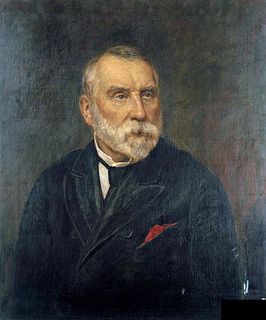
Wembley Park is a London Underground station in Wembley Park, north west London. The station is served by the Underground's Metropolitan and Jubilee Lines and is in Travelcard Zone 4. It is located on Bridge Road (A4089) and is the nearest Underground station to the Wembley Stadium and Wembley Arena complex. This is where the Jubilee line from Stanmore diverges from the Metropolitan line which was formerly a branch of the Metropolitan Railway and was taken over by the Bakerloo line and today part of the Jubilee line.

Watkin's Tower was a partially completed iron lattice tower in Wembley Park, London, England. Its construction was an ambitious project to create a 358-metre (1,175 ft)-high visitor attraction in Wembley Park to the north of the city, led by the railway entrepreneur Sir Edward Watkin. Marketed as the "Great Tower of London", it was designed to surpass the height of the Eiffel Tower in Paris, and it was part of Wembley Park's emergence as a recreational place. The tower was never completed and it was demolished in 1907. The site of the tower is now occupied by the English national football ground, Wembley Stadium.
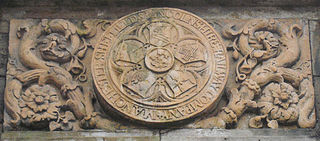
The Manchester, Sheffield and Lincolnshire Railway (MS&LR) was formed by amalgamation in 1847. The MS&LR changed its name to the Great Central Railway in 1897 in anticipation of the opening in 1899 of its London Extension.
The Great Western Railway Sir Watkin Class were 0-6-0T broad gauge steam locomotives with side tanks. They were designed for working goods trains through to the underground Metropolitan Railway in London. This class was introduced into service between December 1865 and the last was withdrawn at the end of the GWR broad gauge in May 1892. They were all named after directors and senior officers of the railway.
John Ross was a Canadian lawyer, politician, and businessman.
Watkin is an English surname formed as a diminutive of the name Watt, a popular Middle English given name itself derived as a pet form of the name Walter.
First found in a small Welsh village in 1629.

The Landmark London is a five-star hotel on Marylebone Road on the northern side of central London, England, in the City of Westminster. It was originally opened by the Great Central Railway, as The Hotel Great Central. As one of London's railway hotels it declined after the advent of the motor car, and served as a military convalescent home during the Second World War, and later the headquarters of the British Railways Board. It reopened as a hotel in 1993.
Charles Reboul Sacré was an English engineer, Engineer and Superintendent of the Locomotive and Stores Department of the Manchester, Sheffield and Lincolnshire Railway. Samuel Waite Johnson was his assistant between 1859 and 1864. Sacre retired in 1886 and committed suicide by shooting himself, reputedly due to the Penistone rail crash of 1884.

The Great Central Main Line (GCML), also known as the London Extension of the Manchester, Sheffield and Lincolnshire Railway (MS&LR), is a former railway line in the United Kingdom. The line was opened in 1899 being built by the Great Central Railway running from Sheffield in the North of England, southwards through Nottingham and Leicester to Marylebone in London.

Sir Watkin Williams-Wynn, 6th Baronet was a Welsh Conservative Party politician who sat in the House of Commons from 1841 to 1885.

Lydd Town was a railway station which served the town of Lydd in Kent, England. Opened on 7 December 1881 by The Lydd Railway Company. It closed to passengers in 1967 but the line through the station remained open for freight.
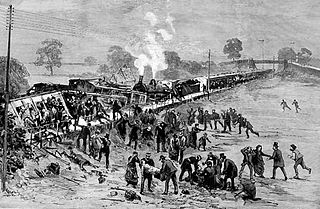
The Hexthorpe rail accident occurred on 16 September 1887 at Hexthorpe railway platform some 1.5 miles (2.4 km) west of Doncaster on the South Yorkshire Railway line to Sheffield and Barnsley. The platform was situated within a block section between Hexthorpe Junction and Cherry Tree Lane and so had no signals of its own. The railway platform was a simple wooden structure on the Doncaster - bound line usually used for the collection of tickets from the many trains arriving in the town for the St. Leger race meeting.
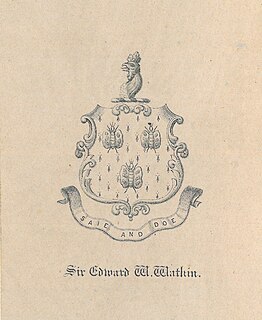
The Watkin Baronetcy, of Northenden in the County Palatine of Chester, was a title in the Baronetage of the United Kingdom. It was created on 12 May 1880 for the railway magnate and politician Sir Edward William Watkin. He was succeeded by his son, Alfred Meller Watkin, the second Baronet, who sat as Liberal Member of Parliament for Great Grimsby. The title became extinct on the second Baronet's death in 1914.
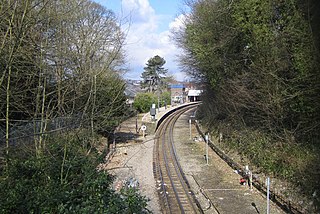
The Chesham branch is a single-track railway branch line in Buckinghamshire, England, owned and operated by the London Underground. It runs from a junction at Chalfont & Latimer station on the Metropolitan line for 3.89 miles (6.26 km) northwest to Chesham. The line was built as part of Edward Watkin's scheme to turn his Metropolitan Railway (MR) into a direct rail route between London and Manchester, and it was envisaged initially that a station outside Chesham would be an intermediate stop on a through route running north to connect with the London and North Western Railway (LNWR). Deteriorating relations between the MR and LNWR led to the MR instead expanding to the northwest via Aylesbury, and the scheme to connect with the LNWR was abandoned. By this time much of the land needed for the section of line as far as Chesham had been bought. As Chesham was at the time the only significant town near the MR's new route, it was decided to build the route only as far as Chesham, and to complete the connection with the LNWR at a future date if it proved desirable. Local residents were unhappy at the proposed station site outside Chesham, and a public subscription raised the necessary additional funds to extend the railway into the centre of the town. The Chesham branch opened in 1889.

Rose Hill in Longley Lane, Northenden, Manchester, England, is a 19th-century Victorian villa, most notable as the home of Sir Edward Watkin, "railway king and cross-channel visionary". The house was designated a Grade II* listed building on 11 April 1991.

The Church of St Wilfrid in Ford Lane, Northenden, Manchester, England, is an Anglican church of late medieval origins which was substantially re-built in the 19th century by J. S. Crowther. The church was designated a Grade II* listed building on 25 February 1952.
The Folkestone, Hythe and Sandgate Tramways operated a tramway service in Hythe, Kent between 1891 and 1921.
Sir Henry Wilson Worsley-Taylor, 1st Baronet or Moreton Hall, was an English politician.
Sir Alfred Mellor Watkin, 2nd Baronet was a Liberal Party politician and railway engineer.
